Nuclear Power Learning and Deployment Rates; Disruption and Global Benefits Forgone
Abstract
1. Introduction
- the additional electricity that could have been generated by nuclear power if the early deployment rate trends had continued
- the number of deaths and quantity of CO2 emissions that could thereby have been avoided.
2. Materials and Methods
- calculate historical OCC learning rates
- estimate the capacity of nuclear power that would have been constructed by 2015 if historical deployment rates had continued
- estimate the OCC of nuclear power in 2015 by applying the pre-1970s learning rates to the capacities estimated from the projected deployment rates
- estimate the quantity of extra electricity that could have been generated by nuclear power if the early deployment rates had continued to 2015; and the deaths and CO2 emissions that could thereby have been avoided.
2.1. Learning Rates
2.2. Deployment Rate Projections
2.3. Projected Overnight Construction Costs in 2015
2.4. Extra Nuclear Electricity, Avoided Deaths and CO2
- CO2 emissions: Coal = 1 Mt/TWh, Gas = 0.6 Mt/TWh (Kharecha and Hansen [17])
3. Results and Discussion
3.1. Learning Rates
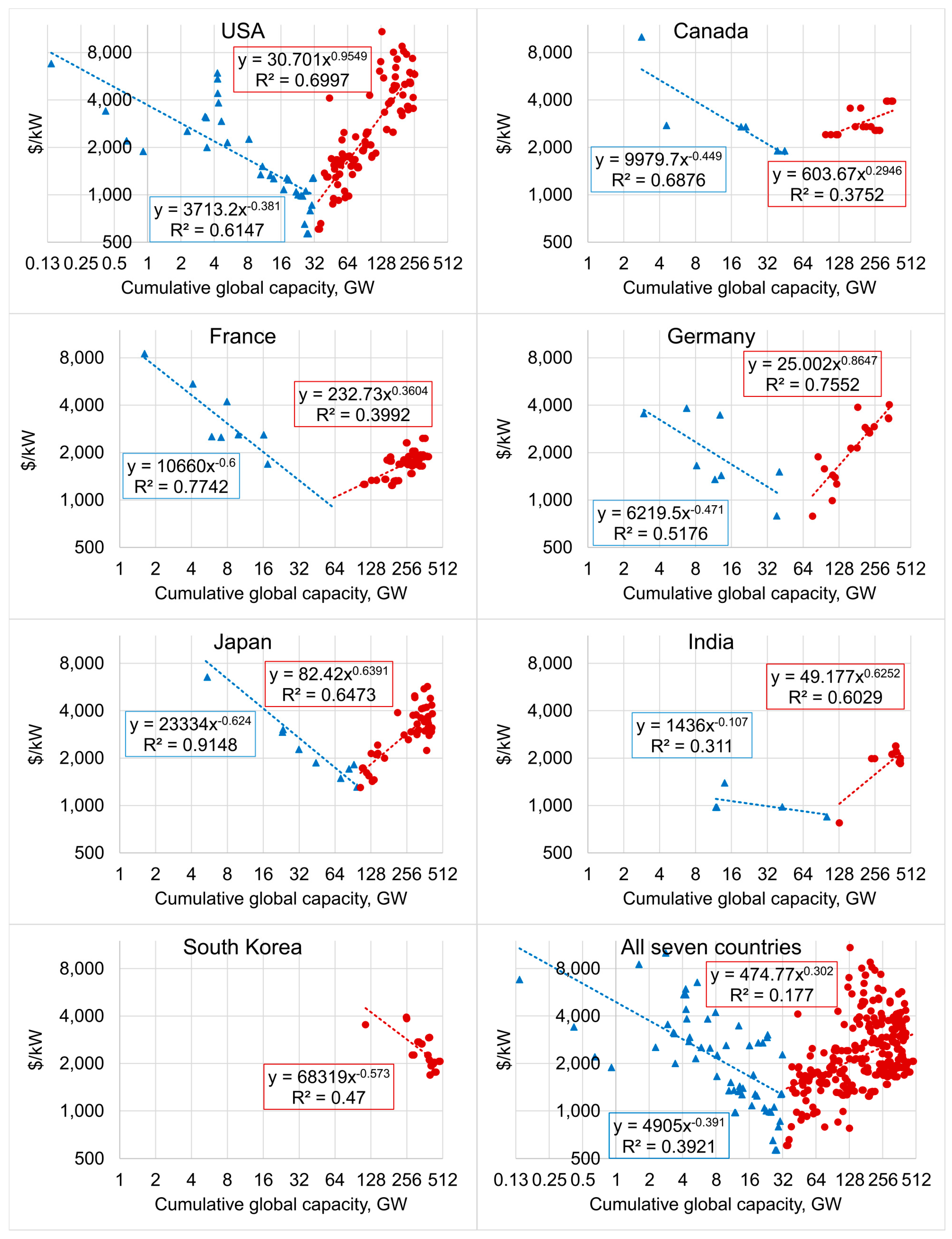
3.2. Deployment Rates and Projections to 2015
3.3. Projected Overnight Construction Costs in 2015
3.4. Extra Nuclear Electricity, Avoided Deaths and CO2
- substituted for 49% of coal-generated electricity, thus avoiding 273,000 deaths and 4.5 Gt CO2 emissions (Linear scenario)
- substituted for 100% of coal- and 76% of gas-generated electricity, thus avoiding 540,000 deaths and 11 Gt CO2 emissions (Accelerating scenario) [XIV].
3.5. Other Benefits Forgone
3.6. Policy Implications
- First, recognise that the disruption to the transition occurred and the impediments to progress continue to this day.
- Second, recognise the consequences of the disruption for the global economy, human wellbeing and the environment, and the ongoing delays to progress.
- Third, identify the root causes of the disruption and cost escalations since, and the solution options.
- Fourth, implement policies to remove impediments that are retarding the transition.
4. Conclusions
Acknowledgments
Conflicts of Interest
Abbreviations
| CO2 | Carbon dioxide |
| OCC | Overnight Construction Cost |
| EIA | Energy Information Administration |
| GDP | Gross Domestic Product |
| GEA | Global Energy Assessment |
| IAEA | International Atomic Energy Agency |
| IEA | International Energy Agency |
| WAES | Workshop on Alternative Energy Strategies |
| WHO | World Health Organisation |
| Gt | gigatonne |
| GW | gigawatt |
| GWh | gigawatt hour |
| MWh | megawatt hour |
| TWh | terawatt hour |
Appendix
Appendix A. Calculation of Extra Nuclear Electricity Generated, Deaths Avoided, CO2 Avoided
Appendix A.1. Calculate Extra Nuclear Electricity Generated
- Accelerating projection: The cumulative global capacity of commercial operation starts is assumed to be equal to the cumulative global capacity of construction starts five years prior minus the cumulative global capacity of reactors permanently shut down. Therefore, the cumulative global capacity of commercial operation starts for a given year is calculated by subtracting five years from construction start date in the equation for the Accelerating projection and subtracting the total capacity of permanent shutdowns to date; that is:where CS means construction start date (at the end of the year, e.g., for 2015, enter 2015.99), and PS means total capacity of reactors permanently shut down to date.0.9886 × (CS − 5)2 − 3878.2 × (CS − 5) + 3,803,469 − PSProjected nuclear electricity generated per year (TWh):
- TWh (projected) = TWh (actual) × [GW (projected) ÷ GW (actual)]
- (This assumes the average capacity factor of the additional plants would have been the same as for the existing plants in each year.)
- Extra TWh = TWh (projected) − TWh (actual)
Appendix A.2. Calculate Deaths Avoided and CO2 Avoided
Appendix B. Notes
- [I]
- Learning curve’ and ‘learning rate’ are used throughout this paper because they are more widely used and recognised than the arguably more appropriate term ‘experience curve’.
- [II]
- [III]
- Lovering et al. [14] define Overnight Construction Cost (OCC) as: “The metric OCC includes the costs of the direct engineering, procurement, and construction (EPC) services that the vendors and the architect-engineer team are contracted to provide, as well as the indirect owner’s costs, which include land, site preparation, project management, training, contingencies, and commissioning costs. The OCC excludes financing charges known as Interest During Construction.”
- [IV]
- Lovering et al. [14], explained why they used construction start dates rather than completion dates:“In contrast to other studies that assess historical cost trends by the reactor’s date of commercial operation (Koomey and Hultman [34] and Grubler [16]), this study uses reactor construction start dates from the IAEA PRIS database, defined as the first foundation concrete pour. Because construction durations have been exceptionally long, up to 10–20 years at the extremes, the state of technology and the reactor designs are not representative of the date of eventual completion, but rather, more representative of the date of the start of construction. Using construction start dates to analyze the nuclear power experience allows for a focus on the cost characteristics of the “best available technology” at the time of deployment, consistent with the technological learning literature.”
- [V]
- The average construction duration of the early nuclear power reactors built globally (i.e., all countries) was: 3.5 years for the first three, 4.0 years for the first ten, 4.4 years for the first twenty, 5 years for the first thirty, and 5.4 years for the first eighty [18]. The first completed US power reactor was constructed and sending power to the grid in 1.8 years [29,35]. That was 60 years ago.It’s useful to compare how construction duration decreased in other large, complex systems as more were built. Fifty Casablanca Class aircraft carriers were built and commissioned for the US Navy between November 1942 and July 1944. The duration was reduced from a maximum of 277 days to 101 days [36]. This represents a learning rate for build duration of 22% for all fifty, and 34% for the last thirty-eight.
- [VI]
- The 114 GW difference between cumulative global capacity of construction starts and of operating reactors is because 67 GW were under construction, with the remainder a combination of power uprates and permanent shutdowns.
- [VII]
- These factors may be underestimates. Assuming the cost of nuclear plants was declining at the pre-reversal learning rates, and no changes to electricity demand profiles, few new coal plants would have been built; therefore, the coal plants that would have been displaced by nuclear would have been older plants of mostly 1950s, 1960s and early 1970s designs. These plants, comprising both black and brown coal, would have had relatively low thermal efficiencies, high emissions intensities of about 0.9 to 1.5 t CO2/MWh and higher levels of pollution harmful to health. Furthermore, the proportion of nuclear replacing fossil fuels in non-OECD countries would have been accelerating, so the global averages for CO2 emissions-intensity, pollution and deaths per TWh would have been higher than the figures quoted above, which are based mostly on the recent periods. The deaths avoided may be underestimated because the accelerating rate of deployment would imply more people would have gained access to electricity; this could have substantially reduced deaths as a result of greater access to clean water and sanitation services and less indoor pollution from burning biofuels and coal for heating and cooking.
- [VIII]
- This note explains why the factor 60 Deaths/TWh, sourced from Wang, 2012 [23], was used for the counterfactual analyses of deaths avoided.60 Deaths/TWh = “coal electricity—world average” (60) minus nuclear (0.09) (Wang, 2012) [23]. Brook et al. [37], use factors sourced from Wang (2011) [38] and modified (Brook, [39]). Conca and Wright [40] quote global average factors in deaths/TWh of 161 for coal, 4 for gas, and 0.04 for nuclear, sourced from Wang (2008) [41]. Kharecha and Hansen [17] use Markandya and Wilkinson [42] factors for the EU average, not the global average; they include an estimated mortality rate for China of 77/TWh, but do not give a global average. Cropper et al. [43] estimate the mortality rate for India at 99/TWh for three pollutants only (PM2.5, SO2, NOx) but do not include life cycle analysis, such as accident fatalities. Hirschberg et al. [44] do not present results for global average deaths/TWh. Following Wang [23], this analysis uses 60 deaths/TWh global average. However, this is an estimate for recent years. The rates have reduced significantly over the period 1985–2015. Therefore, the 60 deaths/TWh rate may be too low for the global average over the period, in which case the estimated number of deaths that could have been avoided may be an underestimate.
- [IX]
- Discussion of the causes of disruption and the cost escalations thereafter is beyond the scope of this paper. However, one cause that has been recognised is real cost increases that applied generally, for example, add-on environmental requirements and materials and labour cost increases (McNerney et al. [45]). However, these are not the root causes. The root causes are what caused the add-on environmental controls, and the materials and labour cost increases.Lovering et al. [14] explain that other electricity generation technologies, such as coal, also experienced increasing costs and negative learning rates since the 1970s, and suggest some possible causes. McNerney et al. [45] shows the learning rate for coal in the US was 12% from 1902 to 2006 (Learning rate = 1 − PR (Progress Ratio)). However, the learning rate from 1968 to 2006 was negative, coinciding with the period of negative learning rates of nuclear in the US (c.f. Lovering et al. [14], Figure 14). The cost of US coal plants increased by a factor of less than 2 during this period, whereas, the cost of US nuclear power reactors increased by a factor of around 7 for construction starts between 1968 and 1978 (the last construction start that went into commercial operation before the end of 2015). Arguably, the cost increases for environmental controls were justifiable for coal but not for nuclear. The nuclear learning rates have not been adjusted to remove the factors that also apply to other technologies.
- [X]
- The IAEA data plotted in Figure 5 include all power reactors that started construction (584 GW), whereas Lovering et al. data (total 497 GW to 2015, including 11 GW added in 2014–2015) exclude those that did not enter commercial operation and demonstration reactor types that did not become commercial.
- [XI]
- WAES [12] said: “Uncertainties surround all our estimates of demand and supply to 2000. Because different countries may choose different nuclear policies, the range of uncertainty in our nuclear projection is greater than for other fuels. On the other hand, extended delays on nuclear programs in various countries could hold nuclear power to the levels projected for 1985, which are based on commitments and construction already under way in most cases. On the other hand, a new awareness of the imminence of a deeper and continuing energy shortfall arising from reduced oil supplies might lead to a public re-appraisal of the risks and benefits of nuclear energy and a decision to accept the risks. All that we can do in this report is to show the scale of the contribution nuclear could make in 2000 and describe the issues in the public debate which will influence each country’s political decision on nuclear risks.”
- [XII]
- Some readers may question the credibility of the projections of OCC in 2015. This is a counterfactual analysis of what the consequences would have been if the pre-disruption learning and deployment rates had continued. There is no apparent physical or technical reason why these rates could not have persisted. Actual learning rates may have been faster or slower than the pre-disruption rates depending on various socio-economic factors. It is beyond the scope of this paper to speculate on what global economic conditions, electricity demand, public opinion, politics, policy, regulatory responses and a multitude of other influencing factors may or may not have occurred over the past half century if the root causes of the disruption had not occurred. However, consider the following. A defensible assumption is that if the high level of public support for nuclear power that existed in the 1950s and early 1960s [12,27,28] had continued, the early learning rates may have continued and, therefore, the accelerating global deployment rate may have continued. With cheaper electricity, global electricity consumption may have been higher, thus causing faster development and deployment. In that case, we could have greatly improved designs by now—small, flexible and more advanced than anything we might envisage, with better safety, performance and cost effectiveness.Rapid learning rates persisted since the 1960s for other technologies and industries, where public support remained high. The aviation industry provides an example of technology and safety improvements, and cost reductions, achieved over the same period in another complex system with high public concern about safety. From 1960 to 2013, US aviation passenger-miles increased by a factor of 19 [46], while aviation passenger safety (reduction in fatalities per passenger-mile) increased by a factor of 1051 [47], a learning rate of 87% for passenger safety. The learning rate for the cost of US commercial airline passenger travel during this period was 27% [46,48]. Similarly, the learning rate for solar PV (with persistent strong public support, favourable regulatory environments and high financial incentives) has remained high at 10 to 47% according to Rubin et al. (Figure 8) [13]. Cherp et al. [49] compare energy transitions of wind, solar and nuclear power in Germany and Japan since the 1970s and find their progress depends on the level of public support, political goals and policies of each country.
- [XIII]
- This figure does not include the deaths that could have been avoided by increasing access to clean water and sanitation services and by reducing indoor air pollution as the declining cost and accelerating deployment of nuclear power enabled electricity to substitute for coal, oil and biofuels (wood, dung and crop residues) used for cooking, heating and lighting.
- [XIV]
- With the Accelerating scenario, nuclear would have generated 66% of global electricity in 2015 (a lesser proportion if global electricity demand had grown faster). Is this a plausible scenario? France provides an example of what was achieved over the period despite the disruption to learning rates. Nuclear was generating 75% of France’s electricity by 1989 and generated 77% of its electricity between 1989 and 2015 [30].
- [XV]
- “A focus on learning rates suggests two general categories of policy options. The first includes policies to speed progress down the learning curve, i.e., to speed the rate at which experience is accumulated in order that costs drop more quickly. The second category includes policies to steepen the learning curve by increasing the learning rate.” (Rogner et al. [26]).
- [XVI]
- Replacing 100% of coal- and 76% of gas-generation globally between 1975 and 2015 is recognised as an unlikely scenario. More likely is that, if the pre-reversal learning rates had continued so costs reduced as projected, demand for electricity would have increased. Electrification could have increased, including to some of the 1.2 billion people who are currently without it. Electricity could have substituted for other fuels, such as for some gas for heat and some oil for transport. Consequently, as demand increased, the extra nuclear generation would have replaced a lesser proportion of coal and gas generation. Therefore, less CO2 would have been avoided. However, perhaps more deaths may have been avoided because of the reduction in deaths from indoor air pollution as electrification expanded into lower-income regions and the reduction of mortality and morbidity as supplies of clean water and sanitation services expanded to people without them.
References
- Goldemberg, J. Energy, Technology, Development. AMBIO 1992, 21, 14–17. [Google Scholar]
- Smil, V. World History and Energy. In Encyclopedia of Energy, 1st ed.; Elsevier Inc.: Amsterdam, The Netherlands, 2004; Volume 6, pp. 549–561. [Google Scholar]
- Smil, V. Energy Transitions: History, Requirements, Prospects; Praeger: Santa Barbara, CA, USA, 2010; p. 178. [Google Scholar]
- Wilson, C.; Grubler, A. Lessons from the History of Technology and Global Change for the Emerging Clean Technology Cluster; International Institute of Applied Systems Analysis (IIASA): Laxenburg, Austria, 2011. [Google Scholar]
- Global Energy Assessment (GEA). Global Energy Assessment—Toward a Sustainable Future; Cambridge University Press: Cambridge, UK; The International Institute for Applied Systems Analysis: Laxenburg, Austria, 2012. [Google Scholar]
- Gohlke, J.M.; Thomas, R.; Woodward, A.; Campbell-Lendrum, D.; Prüss-Üstün, A.; Hales, S.; Portier, C.J. Estimating the global public health implications of electricity and coal consumption. Environ. Health Perspect. 2011, 119, 821. [Google Scholar] [CrossRef] [PubMed]
- WHO. Ambient and Household Air Pollution and Health. Available online: http://www.who.int/phe/health_topics/outdoorair/databases/en/ (accessed on 16 September 2017).
- WHO. Household Air Pollution and Health. Available online: http://www.who.int/mediacentre/factsheets/fs292/en/ (accessed on 16 September 2017).
- International Energy Agency (IEA). World Energy Outlook—Energy Access Database; IEA: Paris, France, 2016. [Google Scholar]
- Grübler, A. Technology and Global Change. Chapter 2. In Technology and Global Change; Cambridge University Press: Cambridge, UK, 2003. [Google Scholar]
- Alstone, P.; Gershenson, D.; Kammen, D.M. Decentralized energy systems for clean electricity access. Nat. Clim. Chang. 2015, 5, 305–314. [Google Scholar] [CrossRef]
- Wilson, C.L. Energy: Global Prospects 1985–000, Report of the Workshop on Alternative Energy Strategies (WAES); McGraw-Hill Book Company: Boston, MA, USA, 1977; p. 291. [Google Scholar]
- Rubin, E.S.; Azevedo, I.M.L.; Jaramillo, P.; Yeh, S. A review of learning rates for electricity supply technologies. Energy Policy 2015, 86, 198–218. [Google Scholar] [CrossRef]
- Lovering, J.R.; Yip, A.; Nordhaus, T. Historical construction costs of global nuclear power reactors. Energy Policy 2016, 91, 371–382. [Google Scholar] [CrossRef]
- Cohen, B. Costs of Nuclear Power Plants–What Went Wrong? In Nuclear Energy Option; Plenum Press: New York, NY, USA, 1990. [Google Scholar]
- Grubler, A. The costs of the French nuclear scale-up: A case of negative learning by doing. Energy Policy 2010, 38, 5174–5188. [Google Scholar] [CrossRef]
- Kharecha, P.A.; Hansen, J.E. Prevented mortality and greenhouse gas emissions from historical and projected nuclear power. Environ. Sci. Technol. 2013, 47, 4889–4895. [Google Scholar] [CrossRef] [PubMed]
- International Atomic Energy Agency (IAEA). Nuclear Power Reactors in the World; IAEA-RDS-2/36; IAEA: Vienna, Austria, 2016; ISBN 978-92-0-103716-9. ISSN 1011-2642. [Google Scholar]
- Energy Information Administration (EIA). International Energy Statistics, Nuclear Electricity Installed Capacity (Million Kilowatts), 1980–2015. Available online: http://www.eia.gov/cfapps/ipdbproject/iedindex3.cfm?tid=2&pid=27&aid=7&cid=regions&syid=1980&eyid=2013&unit=MK (accessed on 6 September 2017).
- International Energy Agency (IEA). Projected Costs of Generating Electricity—2015 Edition; NEA No. 7057; IEA: Paris, France; NEA: Paris, France, 2015; p. 215. [Google Scholar]
- World Bank. GDP Deflator. Available online: https://data.worldbank.org/indicator/NY.GDP.DEFL.ZS?locations=US&page=1 (accessed on 16 September 2017).
- Energy Information Administration (EIA). International Energy Statistics, Nuclear Electricity Net Generation, (Billion Kilowatts-hours), 1980–2015. Available online: http://www.eia.gov/cfapps/ipdbproject/iedindex3.cfm?tid=2&pid=27&aid=12&cid=regions&syid=1980&eyid=2013&unit=BKWH (accessed on 6 September 2017).
- Wang, B. Deaths by Energy Source in Forbes. Available online: https://www.nextbigfuture.com/2012/06/deaths-by-energy-source-in-forbes.html (accessed on 16 September 2017).
- IAEA. Technology Roadmap—Nuclear Energy. 2015 Edition; IEA: Paris, France; NEA: Paris, France, 2015; p. 112. [Google Scholar]
- World Bank. GDP Growth (Annual %). Available online: http://data.worldbank.org/indicator/NY.GDP.MKTP.KD.ZG?view=chart (accessed on 16 September 2017).
- Rogner, H.-H.; Mcdonald, A.; Riahi, K. Long-term performance targets for nuclear energy. Part 2: Markets and learning rates. Int. J. Glob. Energy Issues 2008, 30, 77–101. [Google Scholar] [CrossRef]
- Daubert, V.; Moran, S.E. Origins, Goals, and Tactics of the U.S. Anti-Nuclear Protest Movement; Rand Corporation: Santa Monica, CA, USA, 1985. [Google Scholar]
- Wyatt, A. The Nuclear Challenge: Understanding the Debate; Canadian Nuclear Association: Toronto, ON, Canada, 1978; p. 224. [Google Scholar]
- International Atomic Energy Agency (IAEA). Power Reactor Information System; IAEA: Vienna, Austria, 2016. [Google Scholar]
- The Shift Project Data Portal. Historical Electricity Generation Statistics. Available online: http://www.tsp-data-portal.org/Historical-Electricity-Generation-Statistics#tspQvChart (accessed on 28 September 2017).
- Koomey, J.; Hultman, N.E.; Grubler, A. A reply to “Historical construction costs of global nuclear power reactors”. Energy Policy 2017, 102, 640–643. [Google Scholar] [CrossRef]
- Gilbert, A.; Sovacool, B.K.; Johnstone, P.; Stirling, A. Cost overruns and financial risk in the construction of nuclear power reactors: A critical appraisal. Energy Policy 2017, 102, 644–649. [Google Scholar] [CrossRef]
- Lovering, J.R.; Nordhaus, T.; Yip, A. Apples and oranges: Comparing nuclear construction costs across nations, time periods, and technologies. Energy Policy 2017, 102, 4. [Google Scholar] [CrossRef]
- Koomey, J.; Hultman, N.E. A reactor-level analysis of busbar costs for US nuclear plants, 1970–2005. Energy Policy 2007, 35, 5630–5642. [Google Scholar] [CrossRef]
- American Society of Mechanical Engineers. The Vallecitos Boiling Water Reactor. Available online: http://www.asme.org/getmedia/3663519d-0882-4b7e-ab6c-f036b080cfdd/128-vallecitos-boiling-water-reactor-1957.aspx (accessed on 19 September 2017).
- Naval History. USS Casablanca Class Aircraft Carrier. Available online: http://navalhistory.flixco.info/H/93745x263540/259869/c0.htm (accessed on 19 September 2017).
- Brook, B.W.; Alonso, A.; Meneley, D.A.; Misak, J.; Blees, T.; van Erp, J.B. Why nuclear energy is sustainable and has to be part of the energy mix. Sustain. Mater. Technol. 2014, 1–2, 8–16. [Google Scholar] [CrossRef]
- Wang, B. Deaths per TWh by Energy Source. Available online: https://www.nextbigfuture.com/2011/03/deaths-per-twh-by-energy-source.html (accessed on 16 September 2017).
- Brook, B. (University of Tasmania, Tasmania, Australia); Lang, P. (Australian National University, Canberra, Australia). Personal communication, 2016.
- Conca, J.L.; Wright, J. The Cost of Energy—Ethics and Economics. In Waste Management 2010; Waste Management Symposia: Phoenix, AZ, USA, 2010; Volume 10494, pp. 1–13. [Google Scholar]
- Wang, B. Deaths per TWh for all Energy Sources. Available online: https://www.nextbigfuture.com/2008/03/deaths-per-twh-for-all-energy-sources.html (accessed on 16 September 2017).
- Markandya, A.; Wilkinson, P. Electricity generation and health. Lancet 2007, 370, 979–990. [Google Scholar] [CrossRef]
- Cropper, M.L.; Gamkhar, S.; Malik, K.; Limonov, A.; Partridge, I. The Health Effects of Coal Electricity Generation in India. SSRN 2012, 12–25. [Google Scholar] [CrossRef]
- Hirschberg, S.; Bauer, C.; Burgherr, P.; Cazzoli, E.; Heck, T.; Spada, M.; Treyer, K. Health effects of technologies for power generation: Contributions from normal operation, severe accidents and terrorist threat. Reliab. Eng. Syst. Saf. 2016, 145, 373–387. [Google Scholar] [CrossRef]
- McNerney, J.; Doyne Farmer, J.; Trancik, J.E. Historical costs of coal-fired electricity and implications for the future. Energy Policy 2011, 39, 3042–3054. [Google Scholar] [CrossRef]
- Bureau of Transportation Statistics. National Transportation Statistics. Chapter 1. The Transportation System. Tables 1–40: U.S. Passenger-Miles (Millions) (Updated April 2017). Available online: https://www.rita.dot.gov/bts/sites/rita.dot.gov.bts/files/publications/national_transportation_statistics/html/table_01_40.html (accessed on 16 September 2017).
- Bureau of Transportation Statistics. National Transportation Statistics. Chapter 2. Transportation Safety. Tables 2–9: U.S. Air Carrier Safety Data (Updated April 2016). Available online: https://www.rita.dot.gov/bts/sites/rita.dot.gov.bts/files/publications/national_transportation_statistics/html/table_02_09.html (accessed on 16 September 2017).
- Bureau of Transportation Statistics. National Transportation Statistics. Chapter 3. Transportation and the Economy. Tables 3–20: Average Passenger Revenue per Passenger-Mile (Updated April 2017). Available online: https://www.rita.dot.gov/bts/sites/rita.dot.gov.bts/files/publications/national_transportation_statistics/html/table_03_20.html (accessed on 16 September 2017).
- Cherp, A.; Vinichenko, V.; Jewell, J.; Suzuki, M.; Antal, M. Comparing electricity transitions: A historical analysis of nuclear, wind and solar power in Germany and Japan. Energy Policy 2017, 101, 612–628. [Google Scholar] [CrossRef]
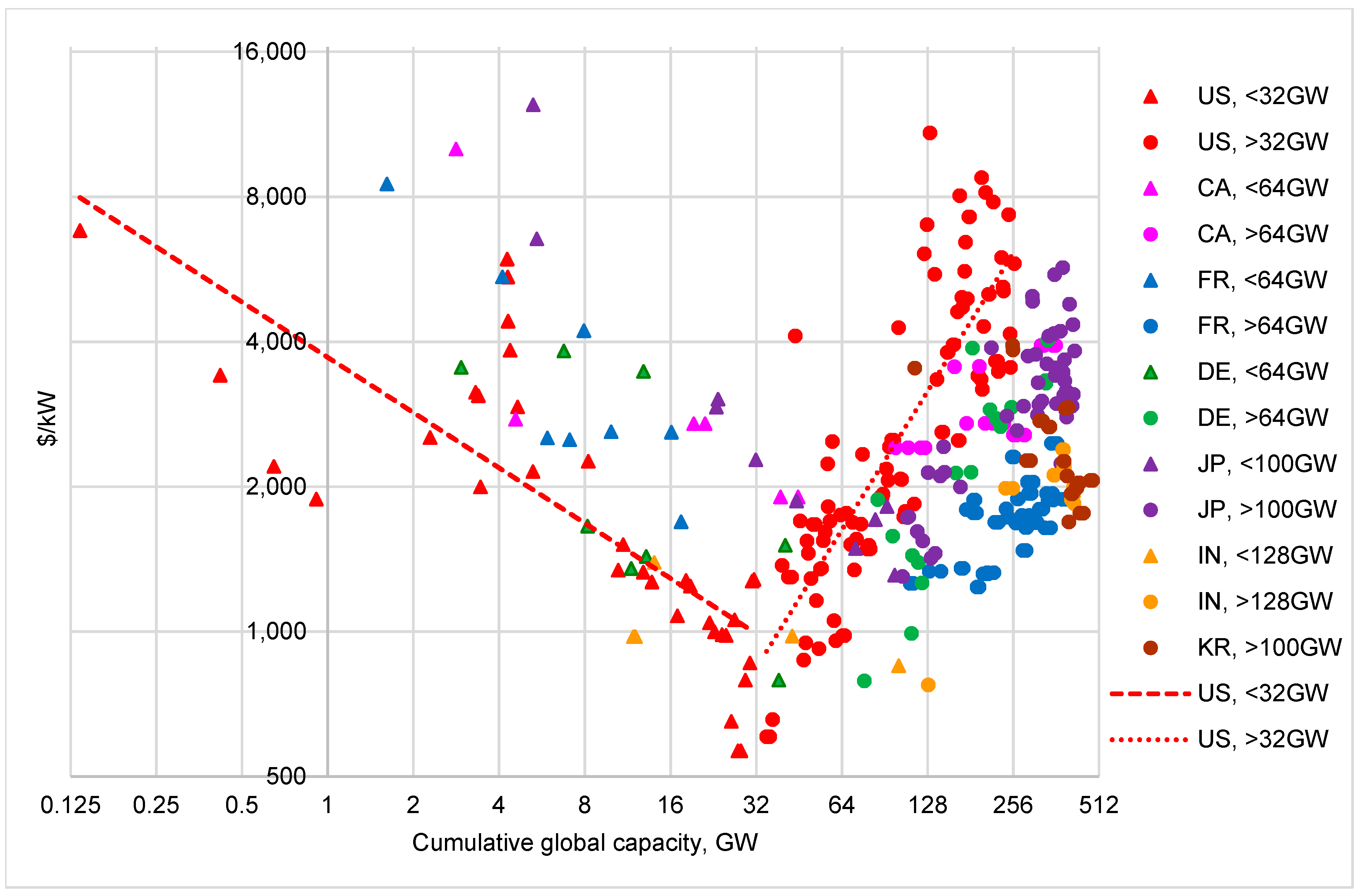
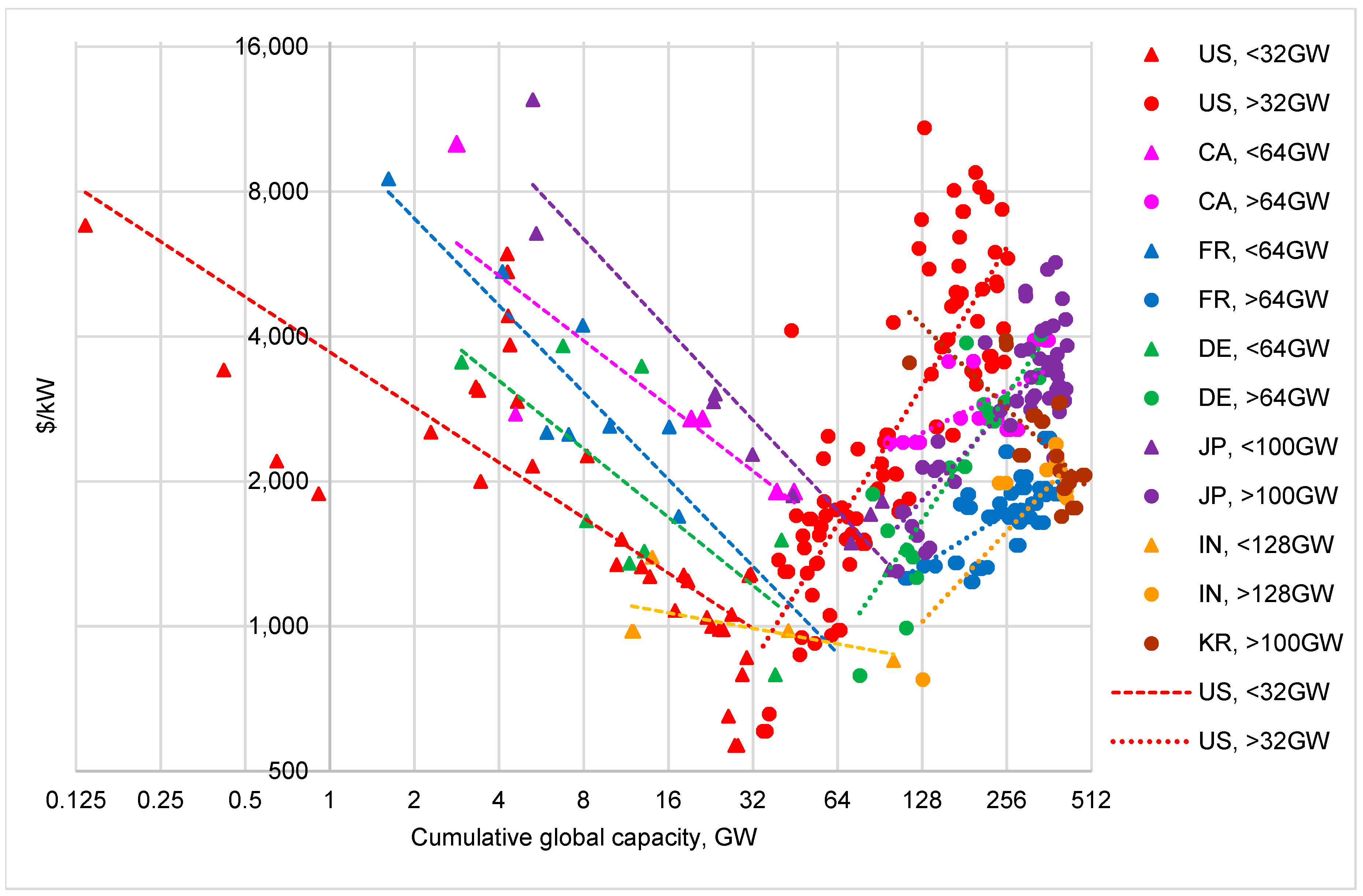
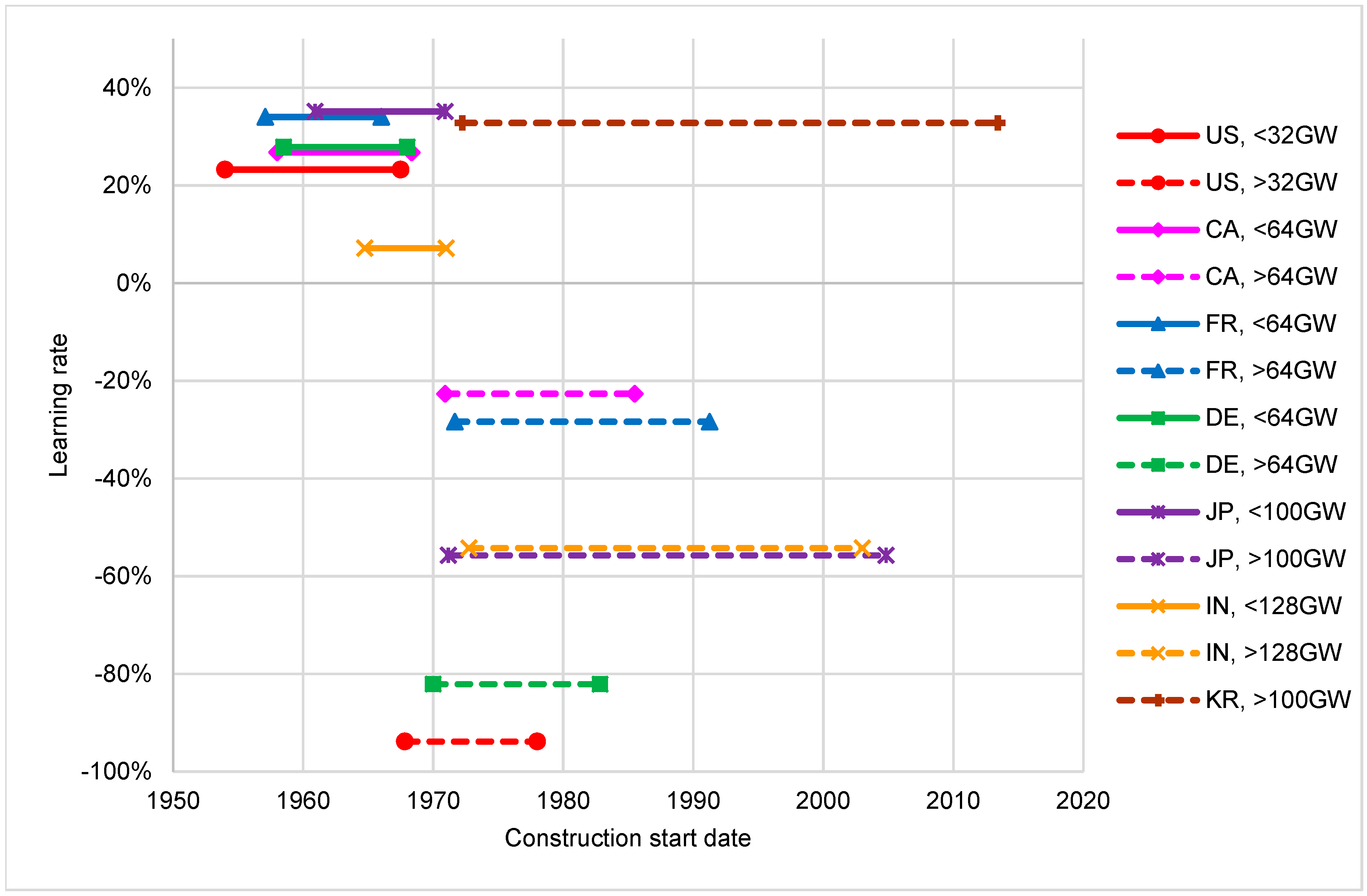
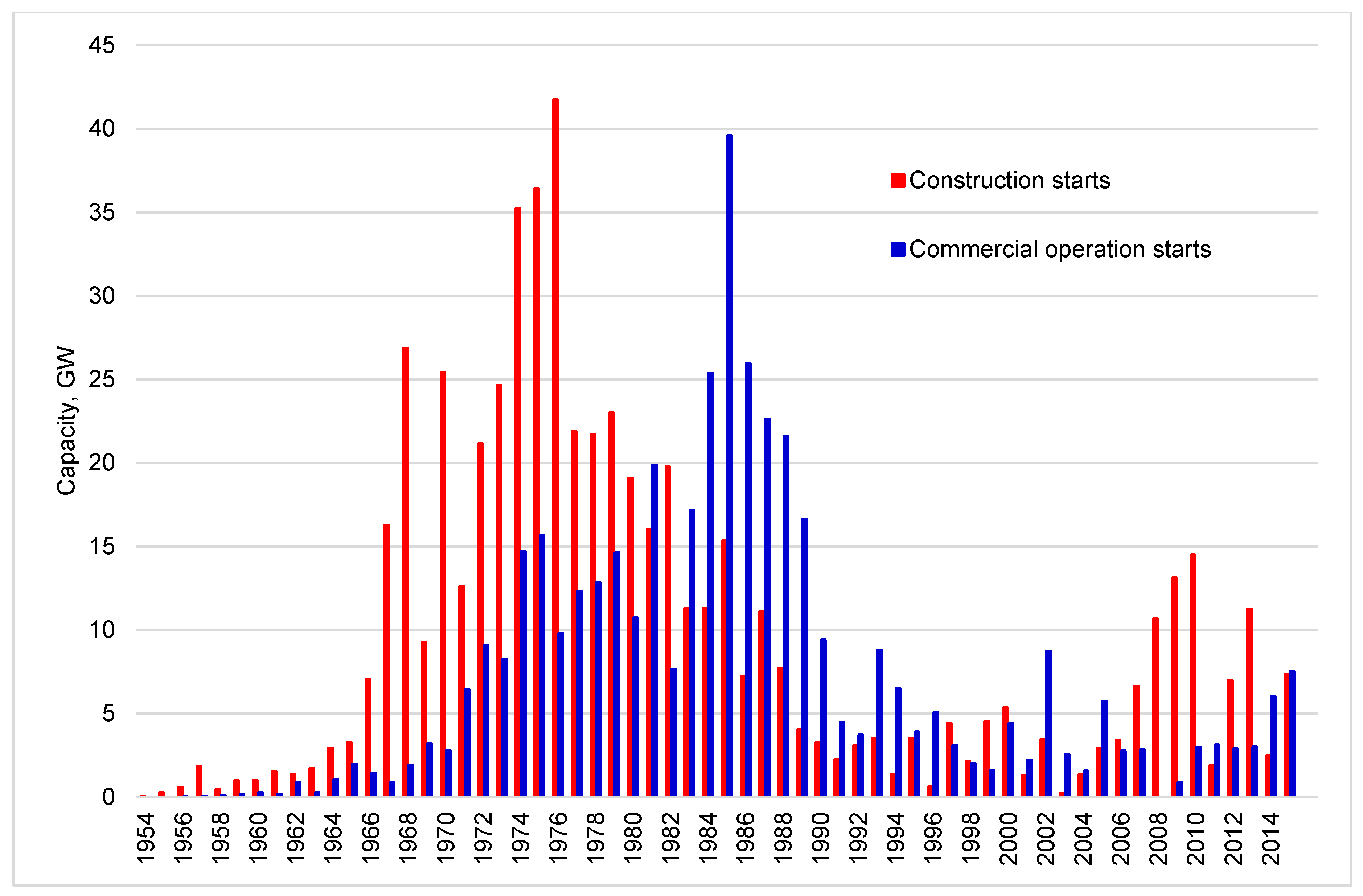
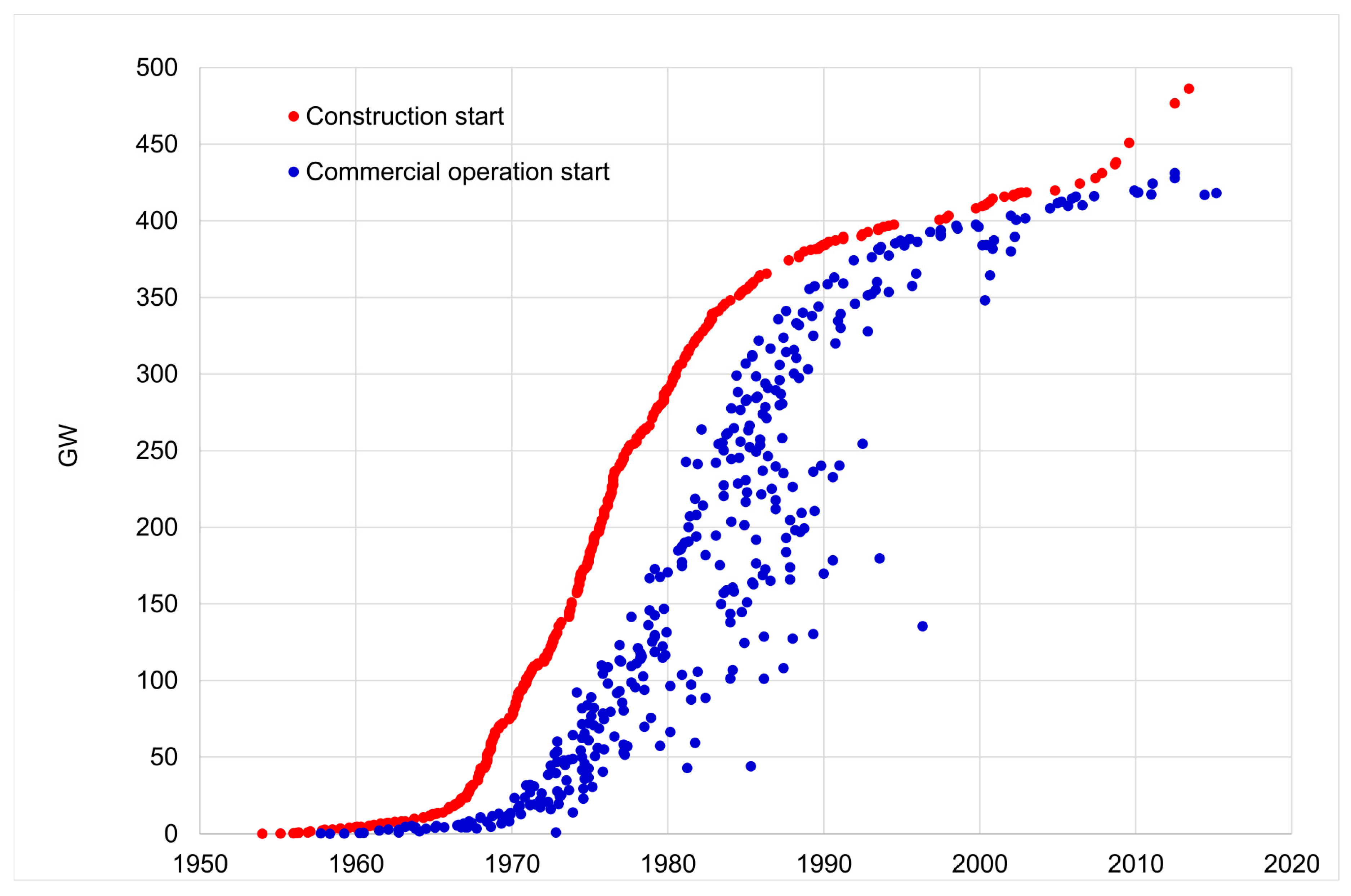
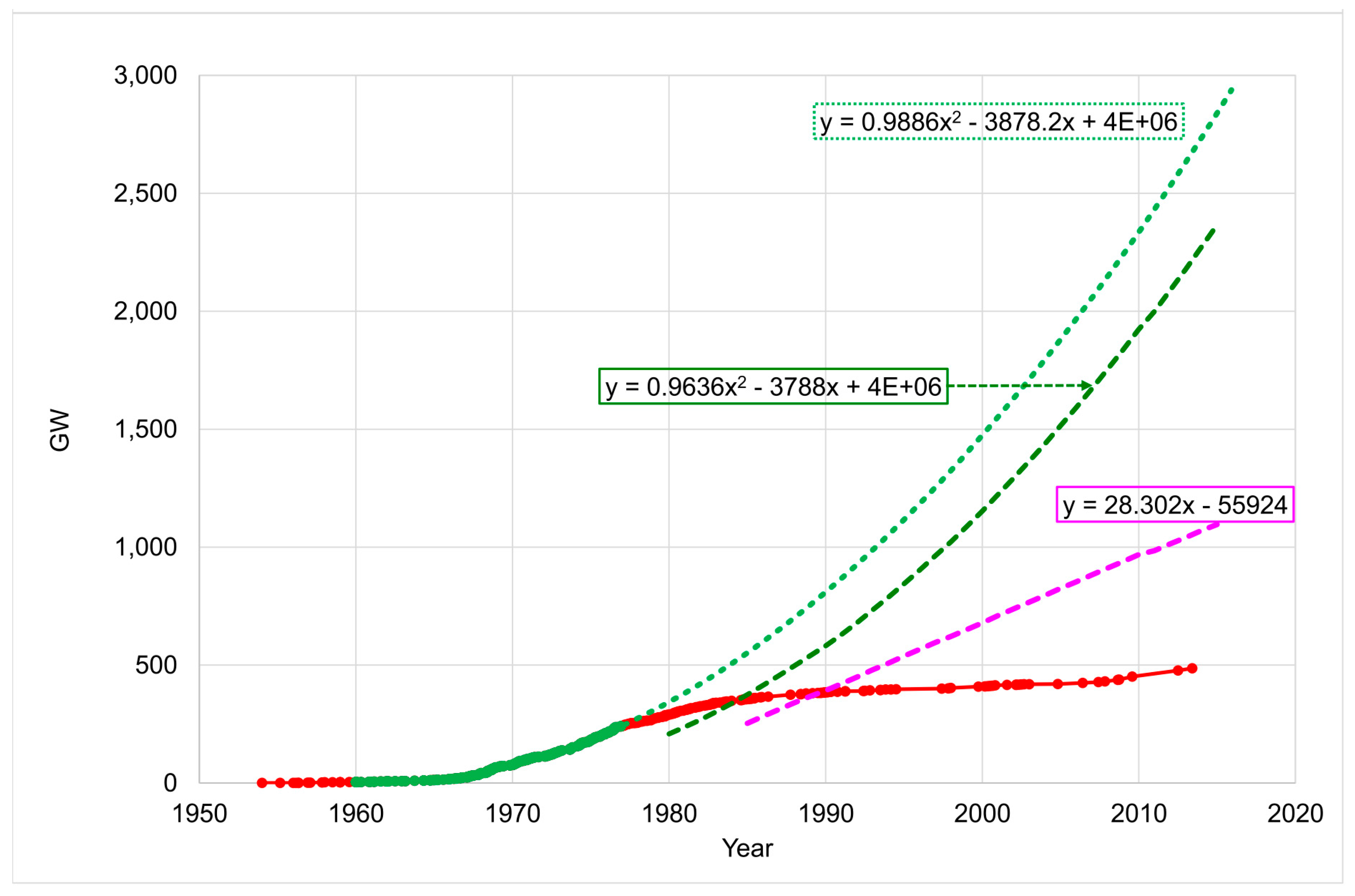
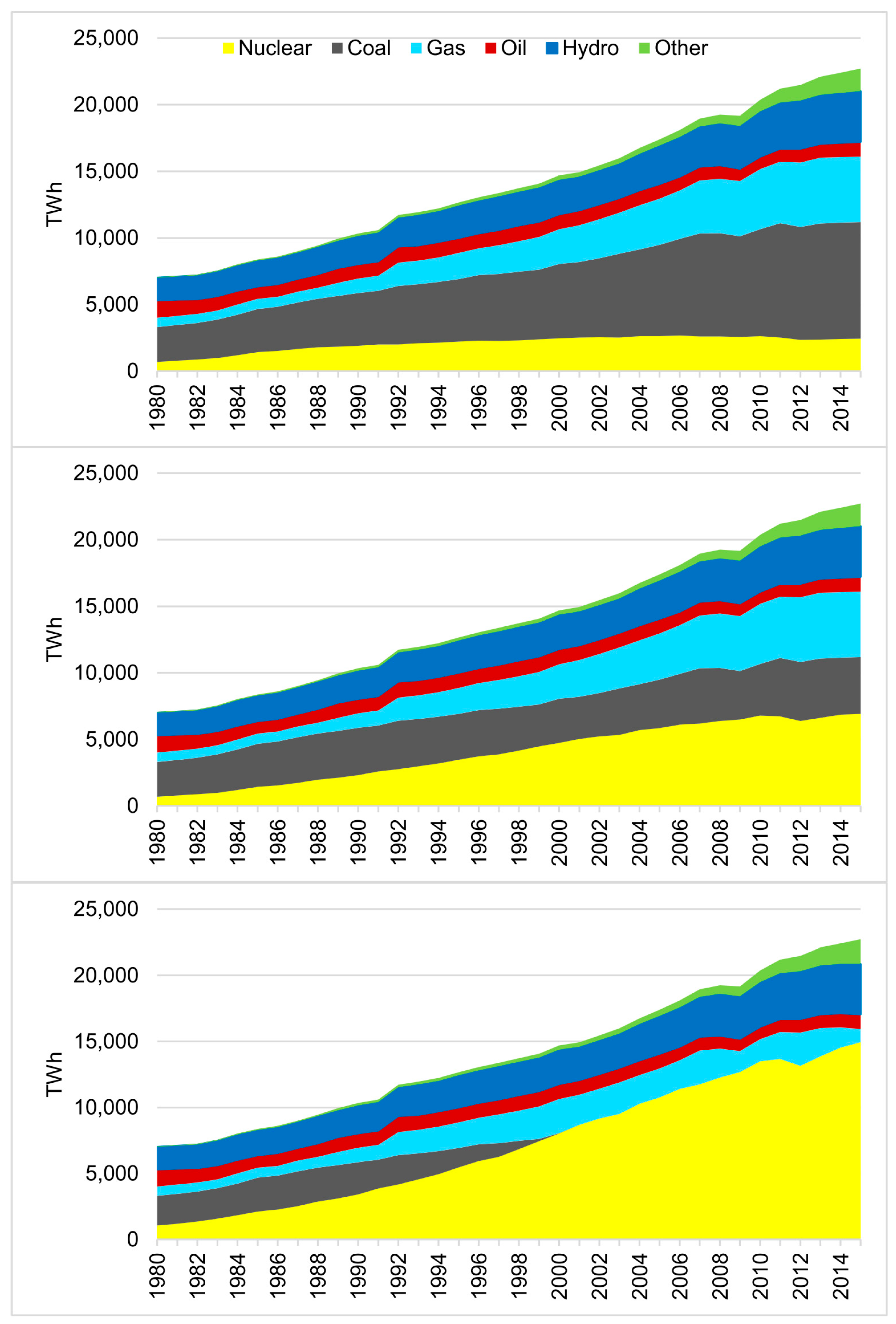
| Country | Pre-Reversal | Post-Reversal | Reversal Point | Projected OCC | |||
|---|---|---|---|---|---|---|---|
| Global | Country | Global | Country | GW | Year | at 497 GW | |
| US | 23% | 24% | −94% | −102% | 32 | 1967 | $349 |
| CA | 27% | 19% | −23% | −20% | 64 | 1968 | $614 |
| FR | 34% | 28% | −28% | −10% | 64 | 1968 | $257 |
| DE | 28% | 16% | −82% | −62% | 64 | 1968 | $334 |
| JP | 35% | 23% | −56% | −35% | 100 | 1970 | $485 |
| IN | 7% | 2% | −54% | −8% | 128 | 1972 | $739 |
| KR | N/A | N/A | 33% | 12% | N/A | N/A | N/A |
| All | 24% | N/A | −23% | N/A | 32 | 1967 | $433 |
| Deployment Rate Scenario | Construction Starts (GW) | Commercial Operation (GW) |
|---|---|---|
| Actual | 497 | 383 |
| Linear | 1246 | 1096 |
| Accelerating | 2941 | 2366 |
| US | CA | FR | DE | JP | IN | All | |
|---|---|---|---|---|---|---|---|
| Learning rate for projections | 23% | 27% | 34% | 28% | 35% | 7% | 24% |
| Overnight Capital Cost (2010 US$) | |||||||
| Deployment rate scenarios | |||||||
| Actual | 349 | 614 | 257 | 334 | 485 | 739 | 433 |
| Linear | 246 | 407 | 148 | 217 | 273 | 670 | 302 |
| Accelerating | 177 | 277 | 89 | 145 | 160 | 611 | 216 |
| Actual OCC | 3881 | 4000 | 4797 | 5000 | 3676 | 2000 | 4022 |
| OCC Change from 2015 Actual | |||||||
| Deployment rate scenarios | |||||||
| Actual | 9% | 15% | 5% | 7% | 13% | 37% | 11% |
| Linear | 6% | 10% | 3% | 4% | 7% | 33% | 8% |
| Accelerating | 5% | 7% | 2% | 3% | 4% | 31% | 5% |
| Benefits Forgone | Units | Linear (1985–2015) | Accelerating (1976–2015) |
|---|---|---|---|
| Extra electricity supplied | TWh | 69,315 | 186,067 |
| Premature deaths avoided | million | 4.2 | 9.5 |
| CO2 emissions avoided | Gt | 69 | 174 |
© 2017 by the author. Licensee MDPI, Basel, Switzerland. This article is an open access article distributed under the terms and conditions of the Creative Commons Attribution (CC BY) license (http://creativecommons.org/licenses/by/4.0/).
Share and Cite
Lang, P.A. Nuclear Power Learning and Deployment Rates; Disruption and Global Benefits Forgone. Energies 2017, 10, 2169. https://doi.org/10.3390/en10122169
Lang PA. Nuclear Power Learning and Deployment Rates; Disruption and Global Benefits Forgone. Energies. 2017; 10(12):2169. https://doi.org/10.3390/en10122169
Chicago/Turabian StyleLang, Peter A. 2017. "Nuclear Power Learning and Deployment Rates; Disruption and Global Benefits Forgone" Energies 10, no. 12: 2169. https://doi.org/10.3390/en10122169
APA StyleLang, P. A. (2017). Nuclear Power Learning and Deployment Rates; Disruption and Global Benefits Forgone. Energies, 10(12), 2169. https://doi.org/10.3390/en10122169





